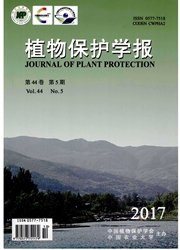

 中文摘要:
中文摘要:
以玉米大斑病菌基因组DNA为模板,采用单因素水平优化的方法对DNA聚合酶的来源及浓度、引物浓度、dNTPs浓度、DNA模板浓度、Tm(退火温度)、PCR反应循环数等重要参数进行摸索和优化,建立了玉米大斑病菌ISSR-PCR优化反应体系,并从40条ISSR引物中筛选出9条多态性较好的ISSR引物。对来自河北、河南、辽宁等玉米主产区的44个菌株进行ISSR分析表明,ISSR标记在我国玉米大斑病菌中存在较高的多态性,多态性条带占40.3%。聚类分析显示,在阂值为0.8时菌株被分为7个类群。对ISSR揭示的玉米大斑病菌的遗传多样性与菌株交配型、地理来源之间的关系进行分析,结果显示菌株的遗传多样性与交配型间的关系密切,而与其地理来源无明显相关性。
 英文摘要:
英文摘要:
By means of the single-factor experiments and using DNA of Exserohilum turcicum as the tem- plate, a suitable ISSR-PCR amplification system was estabhshed and optimized in the Taq DNA polymerase source and concentration, primers, dNTPs concentration, concentration of DNA template, melting temperature (Tm) and the number of amplification cycles. Among the 40 ISSR primers tested in the research, 9 polymorphic primers were screened to study the genetic diversity between 44 isolates of E. turcicure coming from the major corn planting areas in China. 40.3% polymorphic bands were amplified among the tested isolates, indicating the high genetic diversity in the population of E. turcicum in China. The dendrogram based on ISSR results revealed that the 44 isolates were clustered into seven groups at the threshold of genetic similar coefficient 0.8, which proved that the genetic diversity was evidently correlated with mating types, and there was no distinct relation between the fungal genetic diversity and their geographic distribution.
 同期刊论文项目
同期刊论文项目
 同项目期刊论文
同项目期刊论文
 期刊信息
期刊信息
